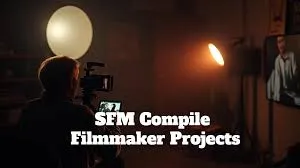Introduction
Welcome to SFMCompile, your comprehensive resource for mastering the art of asset compilation in Source Filmmaker (SFM). Whether you’re a seasoned animator or just starting out, understanding the compilation process is crucial for bringing your creative visions to life. At SFMCompile, we aim to demystify this process, providing you with the tools, knowledge, and community support needed to excel in your projects.
What is SFMCompile?
SFMCompile refers to the process of preparing and converting custom assets—such as models, textures, animations, and maps—for use in Source Filmmaker. This involves transforming these assets into specific formats that SFM can recognize and utilize effectively. By mastering SFMCompile, you unlock the ability to create unique and personalized animations, enhancing the storytelling potential of your projects.
Getting Started with SFMCompile
Embarking on your SFM Compile journey involves several key steps:
1. Preparing Models in 3D Software
Before compiling, models must be properly structured in 3D modeling software like Blender, Maya, or 3ds Max. This includes:
- Ensuring correct model hierarchy: Proper naming conventions for bones, meshes, and materials.
- Applying transformations: Correctly orienting and scaling the model.
- Triangulating the model: Converting all polygons to triangles for compatibility.
2. Exporting to the Correct Format
Models should be exported in formats compatible with SFM:
- SMD (Studio Model Data): Commonly used, though it lacks support for advanced features like shape keys.
- DMX (Data Model eXchange): Supports advanced animations and shape keys but is less commonly used.
3. Writing a QC File
A QC (QuakeC) file is essential for defining how the model should be compiled. It includes information about materials, hitboxes, physics properties, and animation sequences. Here’s a basic example:
qcCopyEdit$modelname "my_model/my_character.mdl"
$cdmaterials "models/my_model/"
$body "Body" "my_character.smd"
$sequence "idle" "idle.smd" fps 30
$collisionmodel "my_character_phys.smd"
{
$mass 10
$damping 0.5
}
4. Compiling with Crowbar
Crowbar is a popular tool for compiling models for SFM:
- Download and install Crowbar.
- Open Crowbar and load your QC file.
- Set the output folder to SFM’s
usermod/models/directory. - Click “Compile” and check for errors.
Upon successful compilation, the model will be converted into .MDL format and placed in SFM’s models directory.
Compiling Textures for SFM
Textures must be converted into formats that SFM can utilize:
1. Converting Images to VTF Format
SFM uses the Valve Texture Format (VTF) for textures:
- Download and install VTFEdit.
- Open your texture file (e.g., PNG, TGA, BMP).
- Adjust compression settings (e.g., DXT5 for transparency).
- Save as a
.VTFfile inside thematerials/models/my_model/directory.
2. Creating a VMT File
A VMT (Valve Material) file tells SFM how to use the texture:
vmtCopyEdit"VertexLitGeneric"
{
"$basetexture" "models/my_model/my_texture"
"$normalmapalphaenvmapmask" "1"
"$phong" "1"
}
Place the VMT file in the same directory as the VTF file for SFM to detect it.
Compiling Animations for SFM
Animations add life to your models:
1. Exporting Animations from 3D Software
Ensure your animations have a proper skeleton and export each animation separately (e.g., idle, walk, run) in SMD or DMX format.
2. Updating the QC File for Animation Sequences
Modify the QC file to include your animation sequences:
qcCopyEdit$sequence "idle" "idle.smd" fps 30 loop
$sequence "walk" "walk.smd" fps 30
$sequence "run" "run.smd" fps 30
3. Compiling the Animation
Use Crowbar or studiomdl.exe to compile the animations, integrating them into your model.
Compiling Maps for SFM
Creating custom environments enhances your storytelling:
1. Creating the Map in Hammer Editor
- Open Hammer Editor.
- Build your map using brushes and props.
- Save the map as a
.VMFfile.
2. Compiling to BSP Format
Use the following tools to compile the map:
- VBSP: Converts raw geometry into a basic map.
- VVIS: Processes visibility optimization.
- VRAD: Applies lighting and shadows.
After compilation, move the .BSP file to SFM’s usermod/maps/ directory.
Troubleshooting Common SFMCompile Errors
Encountering errors is part of the learning process. Here are some common issues and their solutions:
- “Too Many Vertexes” Error: Reduce the polygon count in your 3D modeling software.
- “Material Not Found” Error: Ensure the VMT file is correctly linked in the QC script.
- “QC Compile Failed”: Check for incorrect paths or missing SMD files in the QC file.
- “Texture Appears Purple and Black”: Verify the VTF and VMT files are in the correct folder.
Joining the SFM CompileClub Community
At SFM Compile Club, we believe in the power of community. Our platform is designed for fans and creators who use Source Filmmaker to share resources, collaborate on projects, and push the boundaries of creative expression. Whether you’re looking for tutorials, feedback, or collaborative opportunities, SFMCompileClub is your hub for growth and inspiration.
Conclusion
Mastering SFMCompile is a journey that enhances your ability to create compelling animations and stories within Source Filmmaker. By understanding and applying the compilation processes for models, textures, animations, and maps, you unlock a new level of creative potential. Remember, every expert was once a beginner—embrace the learning process, and don’t hesitate to seek support from the community.
Ready to take your SFM projects to the next level? Dive into the resources and support available at SFMCompileClub, and let your creativity soar.
